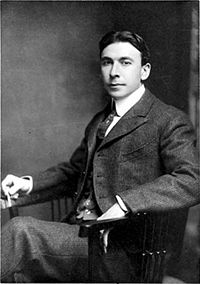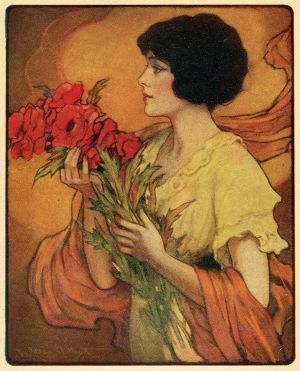Difference between revisions of "Booth Tarkington" - New World Encyclopedia
Lindsay Hull (talk | contribs) |
Lindsay Hull (talk | contribs) (→Legacy) |
||
| Line 13: | Line 13: | ||
==Legacy== | ==Legacy== | ||
| + | Tarkington was very famous in his time for his literary creations. | ||
Tarkington donated substantially to Purdue University and has been recognized for his philanthropy. Tarkington Hall, an all-men's [[Dormitory|residence hall]] at Purdue, is named in honor of him.<ref>Purdue University, ''Tarkington Hall'', [http://www.housing.purdue.edu/HTML/HOUSTarkington.htm ''Tarkington Hall''] Retrieved December 5, 2007.</ref> | Tarkington donated substantially to Purdue University and has been recognized for his philanthropy. Tarkington Hall, an all-men's [[Dormitory|residence hall]] at Purdue, is named in honor of him.<ref>Purdue University, ''Tarkington Hall'', [http://www.housing.purdue.edu/HTML/HOUSTarkington.htm ''Tarkington Hall''] Retrieved December 5, 2007.</ref> | ||
Revision as of 01:20, 23 December 2007
Newton Booth Tarkington (July 29, 1869 – May 19, 1946) was an American novelist and dramatist best known for his Pulitzer Prize-winning novels The Magnificent Ambersons and Alice Adams.
Early Life
Booth Tarkington was born in Indianapolis, the son of John S. Tarkington and Elizabeth Booth Tarkington. He was named after his maternal uncle Newton Booth, then the governor of California. He first attended Purdue University but graduated from Princeton University in 1893. While at Princeton he was editor of the Nassau Literary Magazine and formed the Princeton Triangle Club. He was also voted the most popular man in his class. When Tarkington's class graduated in 1893 he lacked sufficient credits for a degree at Princeton, where he attended classes for two years. His later achievements, however, won him an honorary A.M. in 1899 and an honorary Litt.D. in 1918.
Career
He was one of the most popular American novelists of his time, with The Two Vanrevels and Mary's Neck appearing on the annual best-seller lists nine times.
Tarkington's best known work today is The Magnificent Ambersons, due in part to its famous treatment by Orson Welles in 1942 and its frequently favored listing on the Modern Library's list of top-100 novels. It was the second volume in Tarkington's Growth trilogy, which traced the growth of the United States through the decline of the once-powerful and aristocratic Amberson family dynasty, contrasted against the rise of industrial tycoons and "new money" families in the economic boom years after the Civil War leading up to World War I.
Legacy
Tarkington was very famous in his time for his literary creations. Tarkington donated substantially to Purdue University and has been recognized for his philanthropy. Tarkington Hall, an all-men's residence hall at Purdue, is named in honor of him.[1]
Notes
- ↑ Purdue University, Tarkington Hall, Tarkington Hall Retrieved December 5, 2007.
ReferencesISBN links support NWE through referral fees
- Purdue University. Tarkington Hall. Tarkington Hall Retrieved December 5, 2007.
Further reading
- Tarkington, Booth. The Gentleman from Indiana. New York: Doubleday & McClure Co., 1900.
- Tarkington, Booth. Monsieur Beaucaire New York: McClure, Phillips & Co., 1900. This work was later adapted as a play, an operetta and two films—in 1924 and 1946.
- Tarkington, Booth. The Two Vanrevels. New York: McClure, Phillips & Co., 1902.
- Tarkington, Booth. In the Arena: Stories of Political Life. New York: McClure, Phillips & Co., 1905.
- Tarkington, Booth. Beasley's Christmas Party. New York: Harper & Brothers, 1909.
- Tarkington, Booth. Penrod. New York: Grosset & Dunlap, 1914.
- Tarkington, Booth. The Turmoil. New York: Grosset & Dunlap, 1915. This is the first volume of the trilogy Growth.
- Tarkington, Booth. Penrod and Sam. Garden City, NY: Doubleday, Page, and Company, 1916.
- Tarkington, Booth. Seventeen. New York: Grosset & Dunlap, 1916.
- Tarkington, Booth. The Magnificent Ambersons. Garden City, NY: Doubleday, Page and Company, 1918. This book won the 1919 Pulitzer Prize; and was filmed in 1941 by Orson Welles, and remade for TV in 2002. It is the second volume of the trilogy Growth.
- Tarkington, Booth. Alice Adams. New York: Grosset & Dunlap, 1921. This book won the 1922 Pulitzer Prize and was filmed in 1935.
- Tarkington, Booth. Gentle Julia. Garden City, NY: Doubleday, 1922.
- Tarkington, Booth. The Midlander. Garden City, NY: Doubleday, Page and Company, 1924. In 1927, this book was retitled National Avenue. It is the third volume of the trilogy Growth.
- Tarkington, Booth. The Plutocrat. Garden City, NY: Doubleday, 1927.
- Tarkington, Booth. Claire Ambler. Garden City, NY: Doubleday Doran & Co Inc., 1928.
- Tarkington, Booth. Penrod Jashber. New York: Grosset & Dunlap, 1929.
- Tarkington, Booth. Mirthful Haven. Garden City, NY: Doubleday Doran & Co Inc., 1930.
- Tarkington, Booth. Mary's Neck. Garden City, NY: Doubleday, 1932.
- Tarkington, Booth. The Fighting Littles. Garden City, NY: Doubleday Doran & Co Inc., 1941.
- Tarkington, Booth. Presenting Lily Mars. Garden City, NY: Doubleday Doran & Co Inc., 1933. The book was made into a film in 1943.
- Tarkington, Booth. Kate Fennigate. Garden City, NY: Doubleday Doran & Co Inc., 1943.
External links
- Works by Booth Tarkington. Project Gutenberg. Retrieved December 5, 2007.
- Works by Booth Tarkington at Internet Archive. Retrieved December 5, 2007.
- Booth Tarkington at the Internet Movie Database. Retrieved December 5, 2007.
Credits
New World Encyclopedia writers and editors rewrote and completed the Wikipedia article in accordance with New World Encyclopedia standards. This article abides by terms of the Creative Commons CC-by-sa 3.0 License (CC-by-sa), which may be used and disseminated with proper attribution. Credit is due under the terms of this license that can reference both the New World Encyclopedia contributors and the selfless volunteer contributors of the Wikimedia Foundation. To cite this article click here for a list of acceptable citing formats.The history of earlier contributions by wikipedians is accessible to researchers here:
The history of this article since it was imported to New World Encyclopedia:
Note: Some restrictions may apply to use of individual images which are separately licensed.

